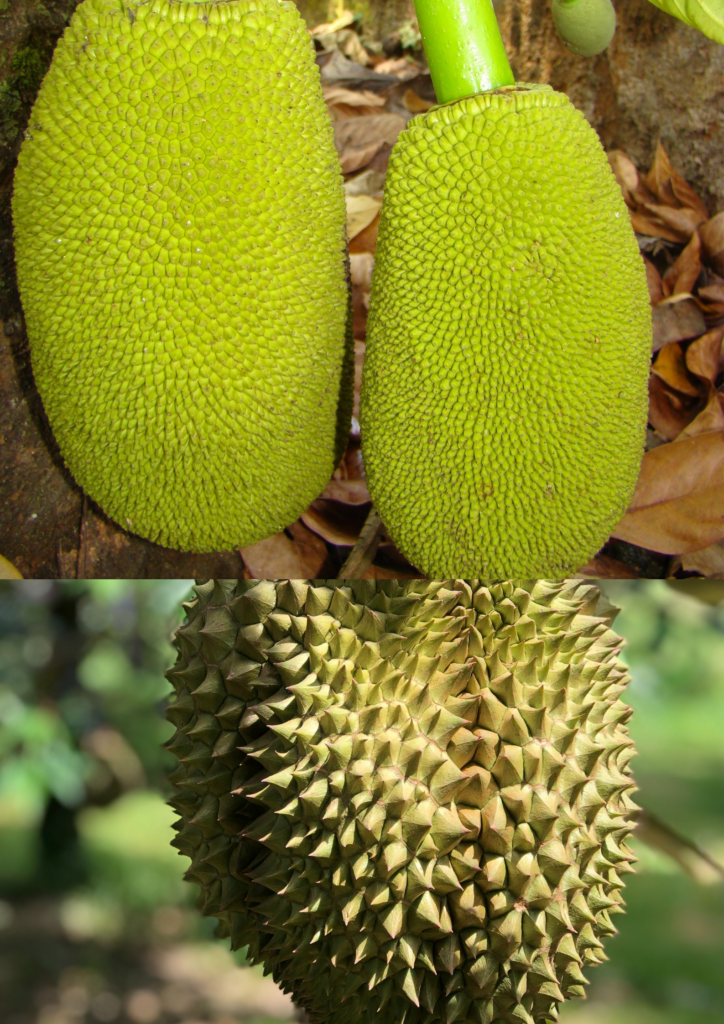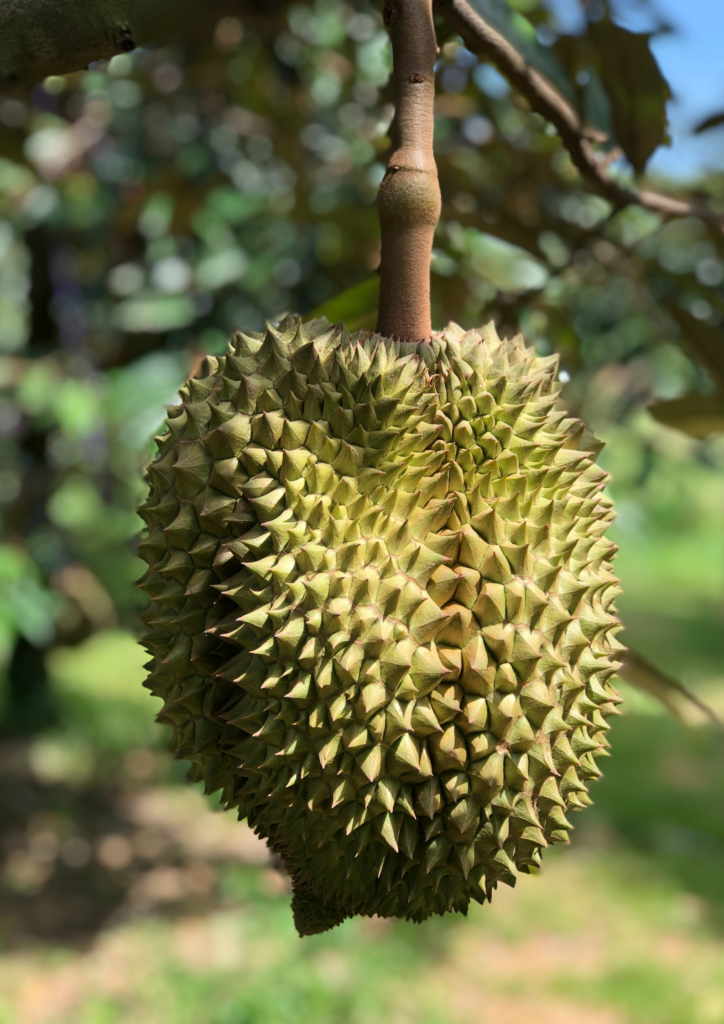
Many Western people are not known many fruit and vegetable species that originated from Asia. Jackfruits, Durians, Longans, Lychee, Rambutan, etc., are some of the Asian fruits imported worldwide. However, many people around the world get confused when differentiating such similar fruits from each other.
Jackfruit and Durian are also two similar-looking fruits of Southeast Asian origin that make people of different regions confused about which one is Jackfruit and Durian.
Untrained fruit lovers often don’t recognize the two as they look the same. But when you keenly study the two, you will be surprised to know that both the fruits don’t even belong to the same family. They have more differences than similarities.
In this article, we will be talking about Jackfruit and Durian. How are they different, and what are their similarities? How can you eat the fruits and different ways of incorporating them into your diet?
This blog post will be part of these questions and a lot more like the smell, taste, origin, cultivation, etc.
So here comes: Jackfruit Vs. Durian, everything that you need to know about these giant fruits.
Jackfruit

Jackfruit is a South Asian fruit that grows on Jack trees, and its scientific name is Artocarpus heterophyllus. The fruit belongs to the family of figs, breadfruit, and mulberry. All of these fruits belong to the Moraceae family.
The origin of Jackfruit is Southeast Asia and, more specifically, the Western Ghats Of India, Sri Lanka, Malaysia, Indonesia, and the Philippines. Jackfruit is actually a group of flowers grown together to make a fruit. It is cultivated commercially across tropical regions around the world.
Although it is believed that jackfruits belong to India, the name is usually referred to be a Portuguese-origin word. The first part of the name is derived from the Portuguese word Jaca.
However, there are many other common names for fruit in Southeast Asia. For instance, it is called Chakka Pazham in India, Kathal in Bangladesh, nangka in Malaysia, and kanun in Thailand.
Origin And Geography
Let’s talk about its origin and geography.
As mentioned earlier, jackfruit originated from Southeast Asian countries. It remained in the Asian region until foreigners in different states of America domesticated the fruit.
In 1563, a physician and naturalist Garcia de Orta gave it jackfruit’s common English name. Before that, it was known for its regional names.
It remained in South Asia and Southeast Asia for years. Java and the Malay Peninsula were the first regions that domesticated the fruit. Later, the fruit was taken to Guam, Spain, and other parts of Europe.
Farming
Unlike in the past, jackfruit is grown now in almost all tropical and sub-tropical regions worldwide. It grows well in the lowlands of tropical demography and alluvial soil with an open texture and fair depth.
The commercial farming of the plant is common in Southeast Asian regions of Malaysia, India, Eastern Africa, the Caribbean, Brazil, Peurto Rico, Australia, Florida, and many Pacific Islands.
The trees have a very low maintenance requirement. Therefore, these are grown as roadside flora in the native countries. However, the plantation of the tree is also common in many forests and woodlots.
Description
Jackfruit is the largest known fruit in the world. It can grow up to 55 kg (120 pounds) in weight. The length and width of the fruit can be up to 35 inches and 20 inches, respectively.
A mature tree of jackfruit has a yield of around 200 fruits per year. Whereas an older one can bear as much as 500 fruits in a year.
If we talk about the appearance of the fruit, one jackfruit is a set of thousands of individual flowers. These flowers have fleshy petals in an unripened fruit.
During the months of July to August, the jackfruit is usually ripened and matured. When the fruit is fully ripened, it is mostly used in desserts.
Smell And Taste
Jackfruits have a uniquely pleasant aroma, and the odor is more like that of a banana or pineapple. If we talk about the taste of the fruit, it has a sweet taste with a hint of pineapple and banana flavor. Jackfruits are very common in sweet dishes, cakes, and different regional dishes.
Nutrients
Sweet-flavored fruit is packed with a lot of nutrients and health benefits. One cup of fruit contains 155 calories, and other nutrients are as follows:
- Vitamin A: 10% of the required daily intake
- Vitamin C: 18% of the required daily intake
- Carbohydrates: 40 g
- Protein: 3 g
- Fiber: 3 g
- Copper: 15% of the required daily intake
- Potassium: 14% of the required daily intake
- Magnesium: 15% of the required daily intake
- Manganese: 16% of the required daily intake
- Riboflavin: 11% of the required daily intake
Health Benefits
Several health benefits of jackfruit that are acclaimed and proven through research studies include the following:
- It is great for controlling blood sugar.
- Vitamin C, carotenoids, and flavanones are anti-oxidants that give jackfruit properties helpful in preventing a lot of chronic diseases, diabetes, and heart strokes.
- Jackfruit helps prevent skin problems due to the presence of anti-oxidants.
- Immune health is also improved by having jackfruit in daily diet.
Durian

Durian is a tropical fruit belonging to the Southeast Asian region and is named the king of fruits. The scientific name of Durian is Durio zibethinus, and it belongs to the Durio genus.
The Durio genus has around 300 species, and only 9 of them bear fruits. Generally, the weight of the fruit is about 1 to 3 kg, and it is round or oblong in shape.
Origin And Geography
Durian is a fruit of Southeast Asian origin, and it is believed to belong to Borneo and Sumatra, India, and New Guinea. The fruit was introduced in Europe during the 15th century.
It spread to the other regions of the world from there. Thailand, South Vietnam, and Myanmar have been the commercial farming hub for four hundred years.
Farming
The commercial farming of the durian fruit is common in Indonesia, Southern Thailand, Malaysia, Phillippines, and other regions. Durian is also cultivated in Hawaii, American Mainland, China, Hong Kong, etc. Since the 1960s, the cultivation of Durian is also done in Australia.
Description
Durian fruit is grown on the tree with oblong tapering leaves and a rounded base. The flowers of the tree are yellowish-green, and the fruit grows along the branches. The shape of the fruit is spherical, and the diameter of the fruit can be between 6 to 8 inches.
Smell And Taste
The scent of Durian can be explained as foul-smelling, and the aroma is often compared to smelly gym socks or rotting flesh to raw sewage. Due to its rotten smell, the fruit is banned in public places in Singapore and Malaysia.
The taste of Durian is a mix of sweet, savory, and creamy blends. Imagine the diced garlic and caramel poured into whip cream; that’s what the Durian tastes like.
Durian is often used in different dishes and culinary. The most common uses of Durian include juices, soups, candies, ice creams, as a side dish, desserts, etc.
Nutrients
Let’s talk about the number of nutrients you get from this rotten-smelling fruit having a sweet taste. You get a large variety of minerals, vitamins, and nutrients with every serving of Durian. 243 grams serving of Durian contains 357 calories and the following nutrients:
- Fiber: 9 g
- Carbs: 66 g
- Protein: 4 g
- Thiamine: 61% of the required daily intake
- Potassium: 30% of the required daily intake
- Vitamin B6: 38% of the required daily intake
- Riboflavin: 29% of the required daily intake
- Copper: 25% of the required daily intake
- Manganese: 39% of the required daily intake
- Vitamin C: 80% of the required daily intake
- Folate: 22% of the required daily intake
- Niacin: 13% of the required daily intake
- Magnesium: 18% of required daily intake
Health Benefits
Several health benefits associated with the use of Durian fruit are as follows:
- The anti-oxidants present in the fruit are good for reducing the risk of cancer.
- Heart diseases, strokes, and cardiovascular problems can be avoided by using Durian as it controls the cholesterol levels
- If you consume Durian, it helps in fighting bacteria and infections due to its anti-bacterial and anti-yeast properties.
- The blood sugar levels can be controlled due to the lower GI of Durian as compared to other tropical fruits.
Comparison Of Jackfruit And Durian
We have discussed almost everything about both exotic fruits: Durian and Jackfruit. The differences between the two fruits can be summarized as follows:
| Jackfruit | Durian |
| The taste of jackfruit is more like a mix of banana or pineapple. | On the other hand, Durian tastes like creamy caramel garlic or cheese. |
| The aroma of jackfruit is also similar to that of pineapple and banana. | It is known to be the stinkiest fruit globally, having the smell close to raw sewage or gym socks. |
| Jackfruit belongs to the family of figs, mulberry, etc. | Durian belongs to the genus Durio. |
| Jackfruit has 11% RDA of Vitamin C. | Durian contains a substantial 44% RDA of Vitamin C. |
| Jackfruit seeds are used as a snack. | Durian seeds are not used. |
Conclusion
We have shared everything that you need to know about the two fruits from the Southeast Asian region. Even if you get confused by the appearance of both fruits, you must know to differentiate between the two. The smell of Durian is enough to tell which fruit you’re buying among the two.
